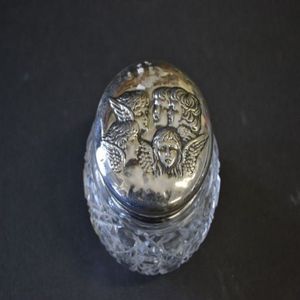Hellenistic Bronze Ring with Garnet Lion Bezel
You must be a subscriber, and be logged in to view price and dealer details.
Subscribe Now to view actual auction price for this item
When you subscribe, you have the option of setting the currency in which to display prices to $Au, $US, $NZ or Stg.
- Garnet - A garnet is a mineral that is commonly used as a gemstone. It occurs in a wide range of colours, including red, pink, orange, green, yellow, and black. The most common and best known type of garnet is the red variety, which has a deep, rich colour and is often referred to as a "garnet red."
Garnets have a long history of use as gemstones, and they have been prized for their beauty and durability for thousands of years. They are often used in jewellery, such as rings, necklaces, and earrings, and they are also sometimes used as a decorative element in other items, such as vases and goblets.
Garnets are prized for their brilliance, durability, and resistance to scratching, making them a popular choice for use in jewellery. They are also valued for their hardness, which makes them well suited for use in abrasive applications, such as sandpaper and grinding wheels. - Bronze - An alloy of copper and tin, traditionally in the proportions of about 9 parts of copper to 1 part of tin.
The discovery of bronze in Western Asia in the 4th century enabled people to create metal objects which were superior to those previoulsy possible because of its strength and hardness, and it has been used throughout the world for weapons, coins, tools, statuary and other decorative items.
It is very fluid in a molten state, and its hardness, strength when set, and non-corrosive properties makes it most suitable for casting sculpture. - Hellenistic - The Hellenistic period is a period in ancient Greek history
that began after the death of Alexander the Great in 323 BCE and lasted until
the Roman conquest of Greece in 146 BCE. It is named after the Greek word
"Hellenistic," which means "to imitate Greeks."
During the Hellenistic period, the Greek world expanded
beyond the boundaries of Greece and encompassed the territories conquered by
Alexander the Great, including Egypt, Persia, and parts of India. The period
was marked by a fusion of Greek culture with the cultures of these conquered
territories, resulting in a diverse and cosmopolitan society.
The art and architecture of the Hellenistic period were
marked by a new sense of realism and individuality. Artists and architects
experimented with new techniques and styles, and the incorporation of new
materials such as bronze and glass. A number of the best-known works of Greek sculpture belong to this period, including Laocoon and his Sons, Venus de Milo, and the Winged Victory of Samothrace. - Circa - A Latin term meaning 'about', often used in the antique trade to give an approximate date for the piece, usually considered to be five years on either side of the circa year. Thus, circa 1900 means the piece was made about 1900, probably between 1895 and 1905. The expression is sometimes abbreviated to c.1900.
- Bezel - On a clock or watch, the bezel is the metal frame into which the watch or clock glass is fitted. In clocks, the bezel may include a hinge and a flange, in effect a door to the face of the clock. In jewellery the bezel is a band of metal with a projecting lip that holds the gemstone in its setting.
Visually similar items

An 18ct white gold diamond ring, fifty three round brilliant cut diamonds, 0.31ct mounted in a filigree circle ring, size M Wt 7.2 grams

Unusual Chinese bronze brush rest in shape of sage with a teapot. Length 10 cm.

Edwardian sterling silver top Reynolds 4 Angel hobnail glass trinket jar

A Helmet, North Central Ifugao, North Luzon, Philippines, (early twentieth century), carved hardwood, 13.5 cm high (20.4 cm diameter). Provenance: William Beyer, Manila. Acquired from above by Dr Peter Elliott, 1960s-1970s. Exhibited: Opening Exhibition As
